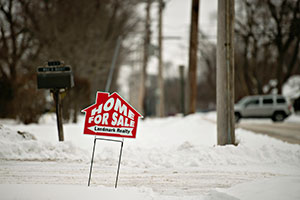Sales of Existing Homes Rise in December

Purchases of previously owned U.S. homes rose less than forecast in December as higher prices discouraged first-time buyers.
Contract closings increased 2.4% to a 5.04 million annual rate from a 4.92 million pace in the prior month, figures from the National Association of Realtors showed Jan. 23 in Washington. The median forecast of economists in a Bloomberg News survey called for a rise to 5.08 million. The number of available properties was the smallest in almost two years.
“The momentum is modest at best,” David Sloan, a senior economist at 4Cast Inc. in New York, said before the report. “The industry will grow, but slowly. There’s a limited number of first-time buyers.”
The share of Americans purchasing their first home dropped in 2014 to its lowest level in almost 30 years, according to the Realtors group. At the same time, employment gains and mortgage rates at historically low levels will help underpin demand provided properties remain affordable.
For all of 2014, sales of previously-owned houses fell 3.1% to 4.93 million. The median price last year was the highest since 2007.
“First-time buyers are still missing in action,” Lawrence Yun, NAR chief economist, said at a news conference today as the figures were released. The market in 2014 was “mildly disappointing.”
Falling interest rates, more jobs and higher levels of confidence indicate “pent-up demand continues to build,” he said. “2015 should be a better year.”
The median price of an existing home advanced 6% in December from the same period a year earlier, to $209,500, the report showed.
Estimates in the Bloomberg survey of 76 economists for December sales ranged from 4.93 million to 5.25 million, from a previously reported 4.93 million a month earlier.
First-time buyers accounted for 29% of all purchases in December, down from 31% a month earlier, the report showed.
The number of previously owned homes on the market fell 11.1% to 1.85 million, the fewest since January 2013. At the current sales pace, it would take 4.4 months to sell those houses compared with 5.1 months at the end of the prior month. Less than a five months’ supply is considered a tight market, the Realtors group has said.
Sales of existing single-family homes increased 3.5% to an annual rate of 4.47 million. Purchases of multifamily properties — including condominiums and townhouses — fell 5% to a 570,000 pace.
Total purchases rose 9.8% in the West and 3.8% in the South. Demand fell 3.5% in the Midwest and 2.9 % in the Northeast.
All-cash transactions made up about 26%. Distressed sales, comprised of foreclosures and short sales, in which the lender agrees to a transaction for less than the balance of the mortgage, accounted for 11% of the total, up from November’s 9%.
Even with the gains, the housing recovery still has a ways to go. A record 7.08 million previously-owned houses were sold in 2005. Three years later, existing-home sales plunged to a 13-year low of 4.11 million.
Existing home sales, tabulated when a purchase contract closes, account for more than 90% of the residential market. New-home purchases, which make up about 7% and are tabulated when contracts are signed, are considered a timelier barometer.
Home sales will benefit from the labor market, which is coming off its best year since 1999, with almost 3 million jobs added and an unemployment rate at a more than six-year low.
Low borrowing costs are a help, too. The average 30-year, fixed-rate mortgage was 3.63% in the week ended Jan. 22, according to data from Freddie Mac in McLean, Virginia. It reached a low of 3.31% in November 2012.
Credit conditions continue to ease. The proportion of banks reporting loosening standards for prime mortgages in the past two quarters was the highest since the Federal Reserve began record-keeping in 2007, according to the central bank’s October survey of senior loan officers.
The boost to demand is feeding through into residential construction. Builders began work on 1.01 million houses in 2014, the most since 2007, Commerce Department data showed this week.
Sentiment in the industry is running close to a nine-year high this month, the National Association of Home Builders/Wells Fargo builder sentiment gauge showed.
Minneapolis-based U.S. Bancorp, the nation’s largest regional lender, is among companies encouraged by the recovery in housing. Chief Executive Officer Richard Davis said the outlook for the mortgage business is “really nice,” in part because Americans are putting money into home improvements.
“People who have houses now feel that they’re no longer underwater and they’re willing to invest in them,” he said during an earnings call on Jan. 21. “People who have houses that are now above water are willing to use it as collateral for something else, like a small business, and housing prices slowly but surely are recovering.”
While increasing property values hurt affordability for some prospective buyers, they give homeowners the ability to sell their dwellings.
About 1.2 million more homeowners had 10% to 20% equity at the end of 2014 compared with a year earlier as their houses gained value, according to research company RealtyTrac Inc. An eight-year high in home prices freed them of mortgages that had been underwater, with loan balances exceeding property values, or barely above it in 2013.
Lennar Corp., a Miami-based builder, said it expects the industry will keep expanding even though profit margins are being hurt by a reduced ability to raise prices.
“While a number of macroeconomic factors have contributed to ongoing choppiness in the recovery, with more pressure on sales prices and gross margins, we remain optimistic about the continuation of the recovery,” CEO Stuart Miller said in an earnings statement on Jan. 15.


